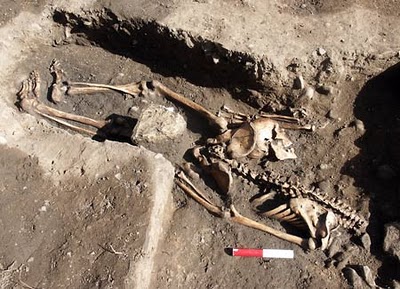 King Tut died from sickle-cell disease, not malaria, say experts. German researchers at Hamburg’s Bernhard Noct Institute for Tropical Medicine (BNI) have rejected a theory put forward by Egyptian antiquities chief Zahi Hawass, claiming sickle-cell disease (SCD) caused King Tut‘s early demise. A team led by Dr Hawass had said a combination of Khler disease and malaria was the primary cause of Tutankhamun’s death. Yet the German team are calling for more tests on the boy-king’s DNA, which they say will easily confirm or deny their claim.
King Tut died from sickle-cell disease, not malaria, say experts. German researchers at Hamburg’s Bernhard Noct Institute for Tropical Medicine (BNI) have rejected a theory put forward by Egyptian antiquities chief Zahi Hawass, claiming sickle-cell disease (SCD) caused King Tut‘s early demise. A team led by Dr Hawass had said a combination of Khler disease and malaria was the primary cause of Tutankhamun’s death. Yet the German team are calling for more tests on the boy-king’s DNA, which they say will easily confirm or deny their claim.
The BNI team have cast doubt on Hawass’ conclusions, after studying DNA tests and CT-scans used in the article, published in the Journal of the American Medical Association (and accompanied by a host of television documentaries) in February this year.
Hawass’ team claimed DNA tests showed segments of the malaria parasite Plamodium Falciparum. A CT-scan (data of which was also used for this awesome reconstruction of King Tut’s mummy) then showed evidence of Kohler II disease, a bone disorder prohibiting blood flow, in Tutankhamun’s left foot. The team concluded that the king, weakened by the bone disorder, succumbed to malaria.
Yet a letter from BNI‘s Dr Christian Timmann and Prof Christian Meyer to JAMA says Hawass may be mistaken. Malaria in combination with Khler’s disease causing Tutankhamun’s early death seems unlikely to us, they say. The BNI team feels the hereditary SCD would have been a far more probable cause of death.
Timmann and Meyer also note that bone abnormalities shown on the mummy’s CT-scans can be interpreted differently. They claim the defects, though consistent with Khler’s disease, are also compatible with osteopathologic lesions seen in SCD.
Sickle-cell disease – a genetic blood disorder characterised by red blood cells assuming a sickle shape – occurs frequently in malarial regions, and can result in complications like the bone disfigurements discovered on King Tut.
The genetic predisposition for (sickle-cell disease) can be found in regions where malaria frequently occurs, including ancient and modern Egypt. Meyer explains. The disease can only manifest itself when sickle cell trait is inherited from both parents, it is a so-called recessive inheritance. The haematological disorder occurs in 9 to 22 per cent of people living in Egyptian oases. Having just one of the two alleles of SCD gives a better chance of survival in malaria-endemic areas, when infestation is halted by the sickling of the cells it infests.
It is known to those who study tropical diseases, writes Timmann, that in areas where malaria occurs deaths due to malaria occur most frequently during childhood. Tutankhamun died aged 19, making a malaria-related death improbable. However SCD, while inherited at birth, is most likely to result in fatal complications between childhood and early adulthood.
A family tree of King Tut, suggested by Hawass himself, appears to further the German team’s case. The relatively old age of Tutankhamun’s parents and relatives up to 50 years means they could very well have carried the sickle-cell trait, and could therefore have been highly resistant to malaria. The high likelihood that King Tut’s parents were in fact siblings means he could have inherited the gene from both and suffered from SCD.
Sickle-cell disease is an important differential diagnosis: one that existing DNA material can probably confirm or rule out, conclude Timmann and Meyer. They suggest that further testing of ancient Egyptian royal mummies should bear their conclusions in mind.
King Tut’s young demise has long been a source of speculation. As well as malaria, recent decades have seen scholars argue that he was murdered, and that he died from infection caused by a broken leg.



